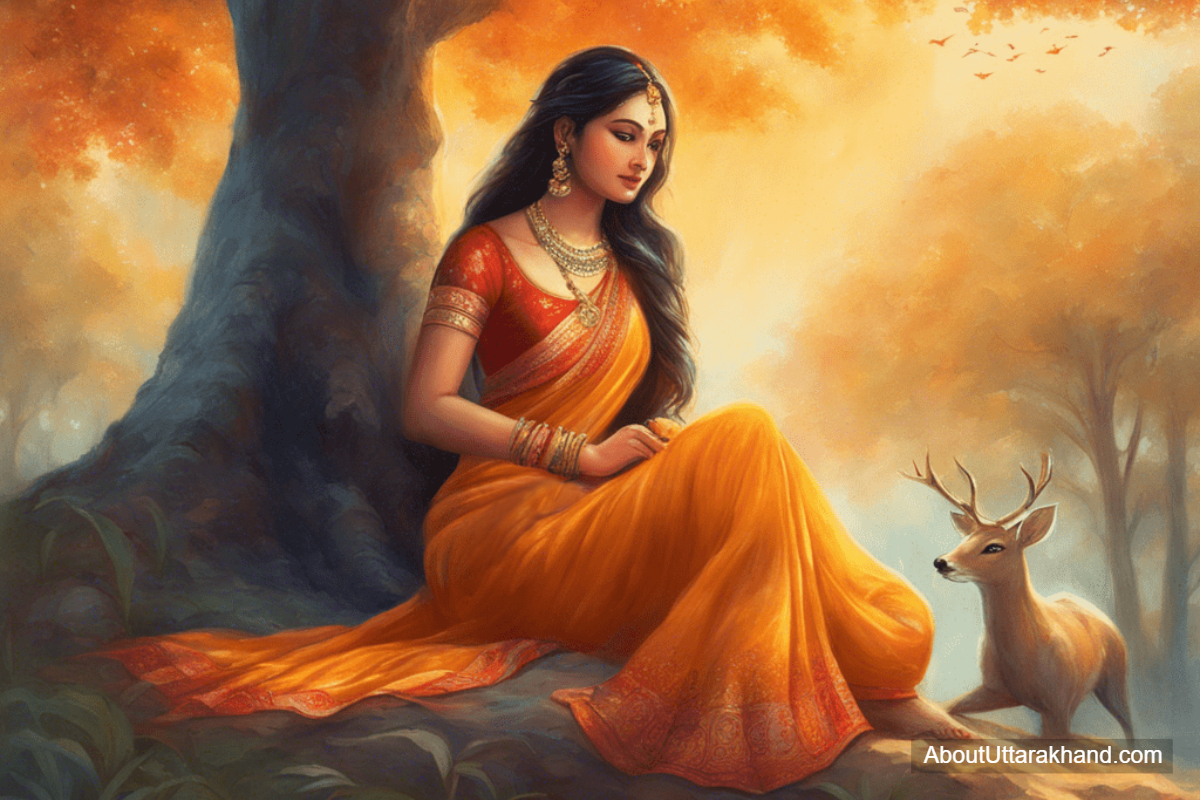Ramayana
Hindu mythology has a lot of stories, but the Ramayana is one of the most famous. It's about righteous behaviour, devotion, and morals. This novel, which is said to have been written by the famous sage Valmiki, tells the story of Prince Rama, his wife Sita, and their loyal friend Hanuman as they deal with the challenges of life, duty, and fate.
The Ramayana has more than 24,000 verses that are full of knowledge that speak to people of all ages and from all over the world. Its story is timeless and applies to all places. It gives us deep insights into the human situation and the never-ending battle between good and evil.
Table of Contents
RamayanaDetails About Ramayana
Lessons and Teachings Of Ramayana
Some Facts About Ramayana
To Conclude

Ramayana - Holy Book Of Hinduism | Photo: AboutUttarakhand.com
Details About Ramayana
The Ramayana, one of the most famous and oldest Indian epic tales, captivates people all over the world. Valmiki wrote the Ramayana, which is about Lord Rama, who is a form of Vishnu, going after Ravana to save Sita. The seven Kandas in the epic cover mythology, mysticism, and morals, and they have inspired readers for many years.
In the Ramayana, Balakanda talks about Rama's divine birth, upbringing, and early experiences. Rama is the oldest son of King Dasharatha of Ayodhya. He stands for goodness, fairness, and following the rules. His adventures as a child, like killing monsters and marrying Sita, set the stage for the drama that comes next.
When Rama's wife Kaikeyi tricks his father into sending him out of his realm in the second book, Ayodhyakanda, things get very exciting. Rama agrees to live in the forest for fourteen years with his wife, Sita, and brother, Laxmana. This is a sign of sacrifice and duty.
In the third book, Aranyakanda, Rama, Sita, and Laxmana go into the bush and meet sages, demons, and animals from legends. This great chapter talks about strength, faith, and how the main characters are tested as they are sent into exile.
In the fourth book of the Ramayana, Kishkindhakanda, Rama forms a bond with Sugriva, the banished monkey king, and Hanuman, his loyal servant. In their trip to Lanka to save Sita from Ravana, they show friendship, loyalty, and the strength of working together when things go wrong.
Sundarakanda, the second-to-last book of the tale, is about Hanuman's brave journey to Lanka to find Sita and give Rama hope and confidence. Courage, selflessness, and good winning over evil are shown by Hanuman's strength and love for Rama.
The Yuddhakanda, or War Book, tells the story of the great battle between Rama's army and Ravana's army. After a brave and good war, Ravana is beaten and dharma is brought back to life. In this beautiful metaphor for the never-ending battle between good and evil, Rama, who represents divine justice, wins.
Rama goes back to Ayodhya, is crowned king, and then ends his life in Uttarakanda, the last book of the tale. The Ramayana uses Rama's life to teach duty, honour, loyalty, and morals.
Every book in the Ramayana has moral and philosophical lessons that are relevant to all times and countries. The epic's many characters, events, and ideas look into what it means to be human and the eternal battle between good and evil. The Ramayana is a great work of literature and a holy text that inspires and educates people all over the world who are looking for truth and knowledge.
Lessons and Teachings Of Ramayana
The Ramayana, a work of Indian literature, is both an interesting story and a deep moral and ethical guide. The timeless lessons in it still teach people how to deal with life's problems and support duty, loyalty, and compassion.
Rama, the main character in the Ramayana, moves us with his unending goodness. Even though he faced a lot of hardships, his commitment to truth and dharma motivates people to live by their principles. Rama's love for his family, especially Dasharatha and Sita, shows how important family is and how much we should give to them.
Through its diverse cast, the story looks at how complicated people are. Ravana's pride and desire for power show how dangerous it is to have too much ambition. Hanuman, on the other hand, was humble and loyal to Rama because he didn't care about himself.
Through these figures and what they go through, the Ramayana shows how people act and what happens as a result. It pushes us to do our best, stick to our values, and be kind to others.
Along with moral lessons, the Ramayana stresses the importance of working together to overcome hardships. Rama's alliance with his family and Hanuman's Vanara army show how important it is to work together to reach your goals.
Besides being an exciting and brave story, the Ramayana has always been a timeless lesson on how to live a good life. Its lessons teach and empower people of all ages and remind us of what is right and the power of love.
Some Facts About Ramayana
Valmiki wrote the Ramayana in Sanskrit around 500 BCE. It is one of the most famous and important works of epic writing in the world. This story has been told for thousands of years and has captivated people from all over the world and in many languages.
There are a lot of different ways that the Ramayana can be read. Many languages have been used to translate it, and it has been reinterpreted in dance, music, theatre, and writing over the years. It's still popular because it has a lot of different themes that people can relate to.
The Ramayana is important to millions of people in India and Southeast Asia on a spiritual and cultural level, as well as an artistic level. It shows how to behave morally and ethically, how people are connected, and how good and evil are always fighting.
The Ramayana is about Rama and Sita being sent away, being separated, and then getting back together. This story is remembered during Diwali, the Festival of Lights. People are happy to celebrate the victory of light over darkness and of justice over oppression.
The Ramayana has also had an impact on many religious, philosophical, and artistic works. It has such a huge effect on human thought and imagination that it moves people from all walks of life and all religions and languages.
The Ramayana is a timeless story that teaches us about the past. Its intricate web of characters, themes, and morals has inspired and educated generations, proving once again that it is a literary gem.
Cat : Spiritual, CatF : Spiritual














To Conclude
As it talks about loyalty, betrayal, restoration, and forgiveness, the Ramayana gives us deep insights into how people really are. When people read, they experience the complicated things in life and the choices we have to make. Through the experiences of its characters, the epic teaches timeless lessons about life and the soul.
Millions of people follow the Ramayana to become good, gain knowledge, and find endless happiness. Its lessons bring comfort, inspiration, and direction during hard times.
Ramayana is more than just an epic story; it gives spiritual food, moral guidance, and a cultural heritage. Its history tells us of the things that bring people together and how strong love can be in the face of hardship.

Belle Fable, keeps your trend ahead!
Gaumukh Glacier
The stunning Gaumukh Glacier, in the Uttarkashi region of Uttarakhand, India, is situated close to Gangotri and framed by the towering Garhwal Himalayas. Glaciers like this one attract tourists, hikers, and nature lovers from all over the globe because of the deep religious significance they have for Hindus as the headwaters of the holy Ganges River. The ascent to Gaumukh is an adventure in body and spirit, providing an opportunity to commune with the holy and the natural world.
Nandhaur Wildlife Sanctuary
The Nandhaur Wildlife Sanctuary is a haven for wildlife and stunning scenery, set in the tranquil hills of Uttarakhand. This sanctuary, in the Nainital District close to Haldwani, is a paradise for people who appreciate nature and animals. Its varied habitats, which include grasslands, ponds, and thick forests, have earned it recognition across its 269 square kilometers of territory.
Sonanadi Wildlife Sanctuary
The Sonanadi Wildlife Sanctuary invites animal lovers and nature lovers to come and enjoy the quiet beauty of Uttarakhand's serene surroundings. Hidden in the Nainital District, not far from Nainital, lies a refuge that begs to be discovered. Its varied wildlife and flora make this area, which covers around 301.18 square kilometers, a popular destination for ecotourists and those interested in biodiversity.
Binsar Wildlife Sanctuary
The Binsar Wildlife Sanctuary is a haven for wildlife and a monument to Uttarakhand's rich biodiversity, is situated in the picturesque Kumaon Himalayas. Nature lovers and wildlife aficionados will find this refuge, situated near Almora in the Almora District, to be a paradise. Covering about 47.04 square kilometers, it is famous for its verdant forests, varied fauna, and breathtaking views of the Himalayan mountains in the distance.
Tawaghat Wildlife Sanctuary
The Tawaghat Wildlife Sanctuary is a haven for adventurers and ecotourists, tucked away in the foothills of the towering Himalayas. This hidden gem of a sanctuary is located near Dharchula in Uttarakhand's Pithoragarh District. Despite its relatively tiny size (around 70 square km), this animal sanctuary is just as magical as any other.
Chilla Wildlife Sanctuary
.The Chilla Wildlife Sanctuary, located on the banks of the pure Ganges River, is a living monument to the beauty and variety of Uttarakhand's natural landscape. This sanctuary is a paradise for anyone who love nature and wildlife; it is located in the Pauri Garhwal District, close to Rishikesh. Covering over 249 square kilometers, it is a major wildlife sanctuary in the state that provides a peaceful haven amidst the majestic Himalayas.

